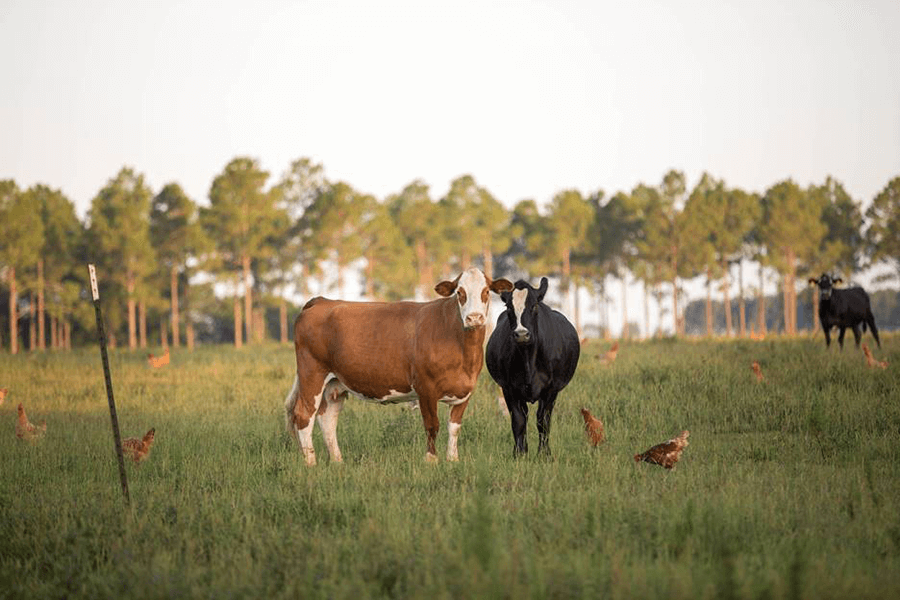Nowadays, it seems more difficult to choose which meat to buy at the grocery than it was for our Paleolithic ancestors to hunt for it. There’s a simple reason for this complex problem: too few labeling options for producers to place on their products. Because the USDA narrowly regulates labeling guidelines and distinctions, companies have little room to distinguish themselves and inform customers of how their animals are treated through the course of their lives. To truly get at the meat of this issue, we’ll need to step and break down the distinct differences between the terms grass-fed, pasture-raised, natural, and organic—and why 100% grass-fed and pasture-raised beef will forever be the gold standard.

Since our company’s inception, we have worked tirelessly to source every one of our products from the best possible suppliers around. We saw early on that the vast majority of the meat industry had slipped into a mindset focused more on quantity over quality, which allowed harmful and irresponsible practices to fester. But as EPIC’s mission for better animal treatment, better food, and better sourcing has spread, practices and product quality have slowly improved. This especially applies to the beef industry.
If you go to our online store or any Whole Foods, Sprouts, Trader Joes, or Kroger affiliate, you’ll see these words on every single EPIC beef product: “100% Grass Fed Beef.” That means exactly as it sounds: all of the cattle used to create our bars, strips, bites, broths, and cooking fats only consume grass their entire lives—thus ensuring their diet is as close to naturally-intended as possible. The majority of the time, they eat by simply roaming the pastures they live on; but should conditions—such as inclement weather or struggling grasslands—inhibit them from accessing fresh grass, our cattle are provided dried forages, typically in the form of hay. And because our cattle are grass-fed and grass-finished, they never receive an ounce of grain and are never, ever subjected to feedlots.

But when it comes to food, it’s not about what a label says—it’s about what it doesn’t say. The term ‘pasture-raised’ is a great example of that. Say you’re browsing the steak options at your neighborhood store and a 12-ounce cut proudly bears this on its packaging: “100% Pasture-Raised Beef.” That can be a bit misleading. When you think of cows in a pasture, you think of one thing: grass. And that’s mostly true—when properly managed, cows living on a pasture eat grass and help with healing or improving soils. But if a meat label reads as pasture-raised but not grass-fed (as many do), it means the cattle roamed their pastures and were provided optional feed troughs full of supplemental dietary options like soy, corn, or another type of grain. This tactic isn’t natural or better: it’s just easier. Producers may argue this allows them to choose their diet, but it reality enables them to eat items they aren’t supposed to. No matter how you slice it, grain or soy-fed cattle aren’t receiving their naturally-intended diet—and are therefore inferior.
If you see meat labeled as “100% Natural Beef,” turn and run. That label is extremely broad, and does not refer to how an animal was raised or what it was fed. Instead, all it refers to is how the meat was treated and preserved after the cow was harvested. Here’s the USDA’s definition of ‘natural’, which you can find in full here: “A product containing no artificial ingredient or added color and is only minimally processed. Minimal processing means that the product was processed in a manner that does not fundamentally alter the product.” For many, this can be alarming—and helps explain why earlier this year hundreds of thousands of skittles fell out of the back of a pickup truck while en route to a ranch’s cattle troughs. This is just one example of why there is essentially no limit to what can be called natural, so long as it’s not pumped full of artificial preservatives and hormones after passing through the processing plant. If you’re buying ‘natural’ beef, you might be grabbing meat that’s fresh off the feedlot and packed with GMO’s, grains, and even skittles. Don’t be that guy/girl.

And then there’s the term ‘certified organic.’ For the USDA, this is their most clear-cut way to help consumers identify which meats are the primo picks—free from harmful hormones and dangerous chemical additives. But many ranchers argue otherwise, saying the process of becoming (and staying) certified organic is both taxing and costly. They’ve got a point, too. For example, take one look at the extensive government organic guidelines (there’s over 25 synthetic substances allowed for livestock production, for instance) and your head will start spinning. But among this criteria, there isn’t any restriction on grain feeding or feedlots. In fact, a cow that consumes a diet of 100% organic corn and lives in a feedlot its entire life can still be ‘certified organic.’ It’s mind-boggling. As a result, many smaller operations that can’t keep up with the arduous record-keeping and rigid rules that organic certification requires simply have stopped pursuing the label. At a certain point, it can be too much effort for not enough output—especially if ‘organic’ isn’t directly tied to grass-fed and pasture-raised properties.
It’s important to keep things in perspective here. What EPIC is fighting for is food that is better for our animals, ours lands, and our bodies, and is proving grass-fed cattle are the best and most eco-friendly option there is. But alongside that comes easily accessible and transparent information for consumers. That’s why we are continuing our pledge to provide as much information as we can about where we get our animals, how they’re treated, and why there’s still plenty of ways we can improve our sourcing. So the next time you’re at the grocery store, don’t get caught flat-footed and fall for labeling ploys—take a deep breath, read between the lines, and choose grass-fed and pasture-raised beef. Your body, mind, and heart will thank you.


